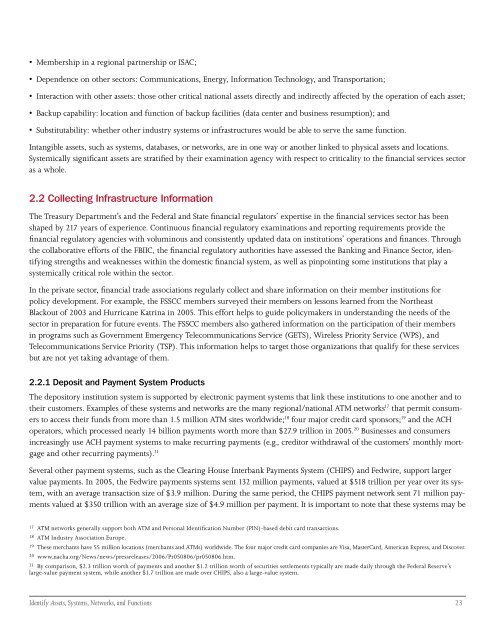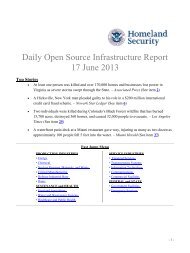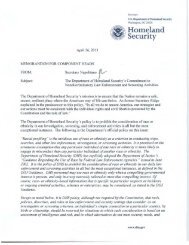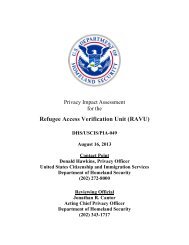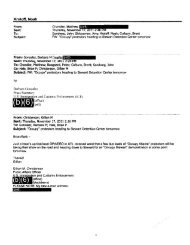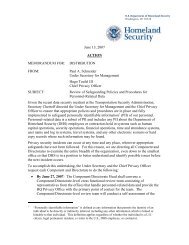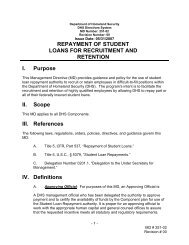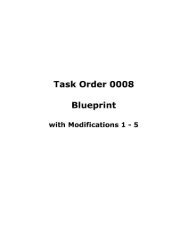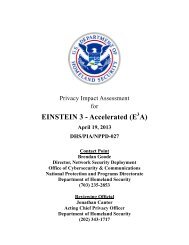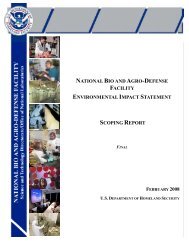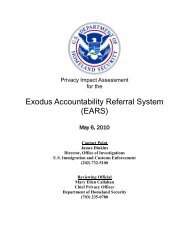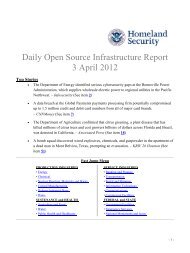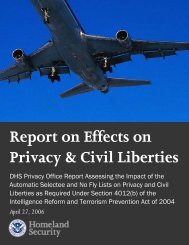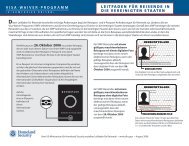Banking and Finance Sector-Specific Plan - U.S. Department of ...
Banking and Finance Sector-Specific Plan - U.S. Department of ...
Banking and Finance Sector-Specific Plan - U.S. Department of ...
You also want an ePaper? Increase the reach of your titles
YUMPU automatically turns print PDFs into web optimized ePapers that Google loves.
• Membership in a regional partnership or ISAC;<br />
• Dependence on other sectors: Communications, Energy, Information Technology, <strong>and</strong> Transportation;<br />
• Interaction with other assets: those other critical national assets directly <strong>and</strong> indirectly affected by the operation <strong>of</strong> each asset;<br />
• Backup capability: location <strong>and</strong> function <strong>of</strong> backup facilities (data center <strong>and</strong> business resumption); <strong>and</strong><br />
• Substitutability: whether other industry systems or infrastructures would be able to serve the same function.<br />
Intangible assets, such as systems, databases, or networks, are in one way or another linked to physical assets <strong>and</strong> locations.<br />
Systemically significant assets are stratified by their examination agency with respect to criticality to the financial services sector<br />
as a whole.<br />
2.2 Collecting Infrastructure Information<br />
The Treasury <strong>Department</strong>’s <strong>and</strong> the Federal <strong>and</strong> State financial regulators’ expertise in the financial services sector has been<br />
shaped by 217 years <strong>of</strong> experience. Continuous financial regulatory examinations <strong>and</strong> reporting requirements provide the<br />
financial regulatory agencies with voluminous <strong>and</strong> consistently updated data on institutions’ operations <strong>and</strong> finances. Through<br />
the collaborative efforts <strong>of</strong> the FBIIC, the financial regulatory authorities have assessed the <strong>Banking</strong> <strong>and</strong> <strong>Finance</strong> <strong>Sector</strong>, identifying<br />
strengths <strong>and</strong> weaknesses within the domestic financial system, as well as pinpointing some institutions that play a<br />
systemically critical role within the sector.<br />
In the private sector, financial trade associations regularly collect <strong>and</strong> share information on their member institutions for<br />
policy development. For example, the FSSCC members surveyed their members on lessons learned from the Northeast<br />
Blackout <strong>of</strong> 2003 <strong>and</strong> Hurricane Katrina in 2005. This effort helps to guide policymakers in underst<strong>and</strong>ing the needs <strong>of</strong> the<br />
sector in preparation for future events. The FSSCC members also gathered information on the participation <strong>of</strong> their members<br />
in programs such as Government Emergency Telecommunications Service (GETS), Wireless Priority Service (WPS), <strong>and</strong><br />
Telecommunications Service Priority (TSP). This information helps to target those organizations that qualify for these services<br />
but are not yet taking advantage <strong>of</strong> them.<br />
2.2.1 Deposit <strong>and</strong> Payment System Products<br />
The depository institution system is supported by electronic payment systems that link these institutions to one another <strong>and</strong> to<br />
their customers. Examples <strong>of</strong> these systems <strong>and</strong> networks are the many regional/national ATM networks17 that permit consumers<br />
to access their funds from more than 1.5 million ATM sites worldwide; 18 four major credit card sponsors; 19 <strong>and</strong> the ACH<br />
operators, which processed nearly 14 billion payments worth more than $27.9 trillion in 2005. 20 Businesses <strong>and</strong> consumers<br />
increasingly use ACH payment systems to make recurring payments (e.g., creditor withdrawal <strong>of</strong> the customers’ monthly mortgage<br />
<strong>and</strong> other recurring payments). 21<br />
Several other payment systems, such as the Clearing House Interbank Payments System (CHIPS) <strong>and</strong> Fedwire, support larger<br />
value payments. In 2005, the Fedwire payments systems sent 132 million payments, valued at $518 trillion per year over its system,<br />
with an average transaction size <strong>of</strong> $3.9 million. During the same period, the CHIPS payment network sent 71 million payments<br />
valued at $350 trillion with an average size <strong>of</strong> $4.9 million per payment. It is important to note that these systems may be<br />
17 ATM networks generally support both ATM <strong>and</strong> Personal Identification Number (PIN)-based debit card transactions.<br />
18 ATM Industry Association Europe.<br />
19 These merchants have 55 million locations (merchants <strong>and</strong> ATMs) worldwide. The four major credit card companies are Visa, MasterCard, American Express, <strong>and</strong> Discover.<br />
20 www.nacha.org/News/news/pressreleases/2006/Pr050806/pr050806.htm.<br />
21 By comparison, $2.3 trillion worth <strong>of</strong> payments <strong>and</strong> another $1.2 trillion worth <strong>of</strong> securities settlements typically are made daily through the Federal Reserve’s<br />
large-value payment system, while another $1.7 trillion are made over CHIPS, also a large-value system.<br />
Identify Assets, Systems, Networks, <strong>and</strong> Functions


